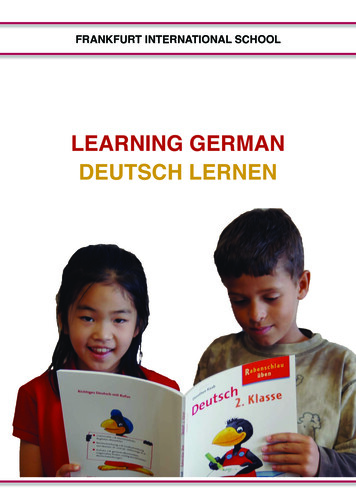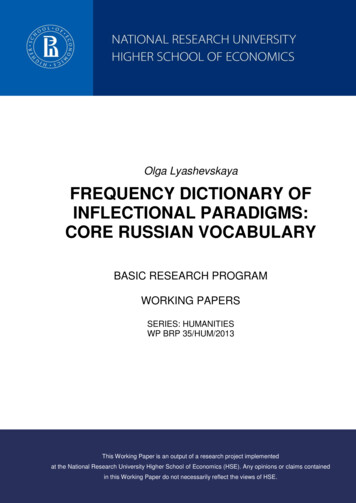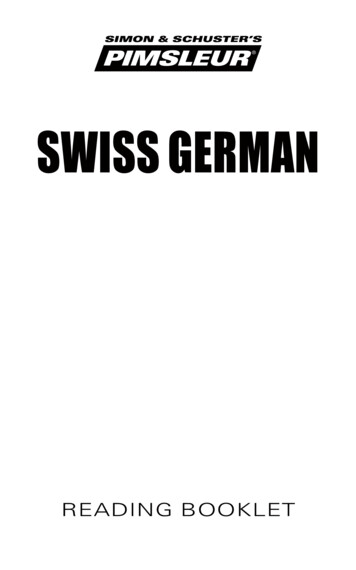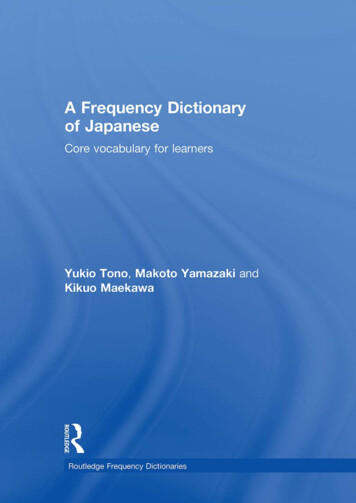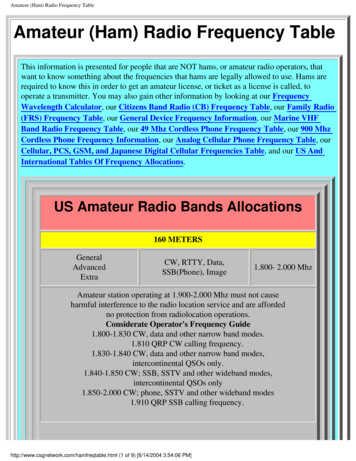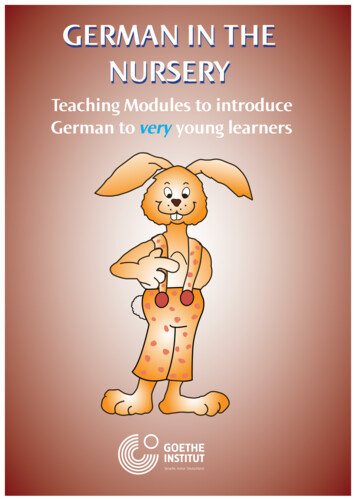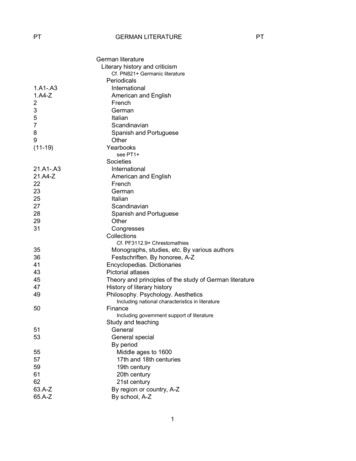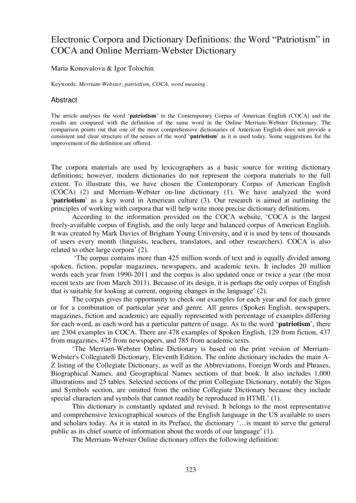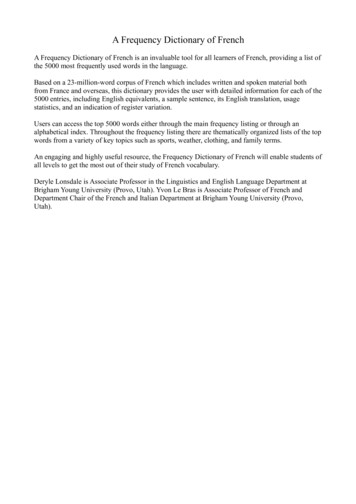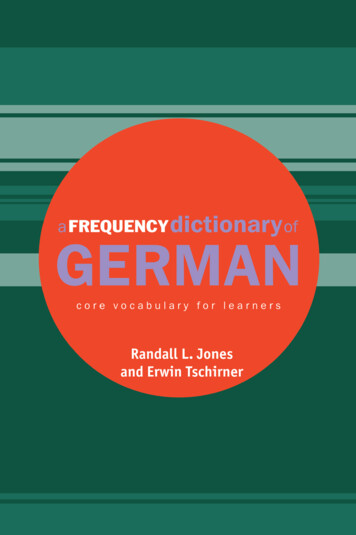
Transcription
A Frequency Dictionaryof GermanA Frequency Dictionary of German is an invaluable tool for all learners of German,providing a list of the 4,034 most frequently used words in the language. Based on a4.2-million word corpus which is evenly divided between spoken, literature, newspaper andacademic texts, the dictionary provides the user with a detailed frequency- based list plusalphabetical and part of speech indexes.All entries in the rank frequency list feature the English equivalent, a sample sentenceplus an indication of major register variation. The dictionary also contains 21 thematicallyorganized lists of frequently used words on a variety of topics as well as eleven specialvocabulary lists.A Frequency Dictionary of German aims to enable students of all levels to maximize theirstudy of German vocabulary in an efficient and engaging way.Randall L. Jones is Emeritus Professor of German at Brigham Young University, and ErwinTschirner is Professor of German as a Foreign Language at the Herder-Institut, Universityof Leipzig.
Routledge Frequency DictionariesGeneral Editors:Anthony McEneryPaul RaysonConsultant Editors:Michael BarlowAsmah Haji OmarGeoffrey LeechBarbara Lewandowska-TomaszczykJosef SchmiedAndrew WilsonOther books in the series:A Frequency Dictionary of Spanish: Core vocabulary for learnershbk 0–415–33428–4pbk 0–415–33429–2Coming soon:A Frequency Dictionary of Polish
A Frequency Dictionaryof GermanCore vocabulary for learnersRandall L. Jones and Erwin TschirnerContributing writers:Agnes GoldhahnIsabel BuchwaldAntina Ittner
First published 2006by Routledge2 Park Square, Milton Park, Abingdon, Oxon OX14 4RNSimultaneously published in the USA and Canadaby Routledge270 Madison Ave, New York, NY 10016Routledge is an imprint of the Taylor & Francis GroupTransferred to Digital Printing 2006 2006 Randall L. Jones and Erwin TschirnerTypeset in Parisine by Keystroke, Jacaranda Lodge, WolverhamptonAll rights reserved. No part of this book may be reprinted or reproducedor utilised in any form or by any electronic, mechanical, or other means,now known or hereafter invented, including photocopying and recording,or in any information storage or retrieval system, without permission inwriting from the publishers.British Library Cataloguing-in-Publication DataA catalogue record for this book is available from the British LibraryLibrary of Congress Cataloging in Publication DataJones, Randall L.A frequency dictionary of German/Randall Jones and Erwin Tschirner. — 1st ed.p. cm. — (Routledge frequency dictionaries)Includes bibliographical references and indexes.1. German language—Word frequency—Dictionaries. I. Tschirner, Erwin P., 1956–II. Title. III. Series.PF3691.J66 2005433’.1—dc22ISBN10: 0–415–31632–4 (hbk)ISBN10: 0–415–31633–2 (pbk)ISBN13: 9–78–0–415–31632–3 (hbk)ISBN13: 9–78–0–415–31633–0 (pbk)2005012949
ContentsThematic vocabulary lists viSeries preface viiAcknowledgements ixList of abbreviations xIntroduction 1Frequency index 9Alphabetical index 139Part of speech index 182
Thematic vocabulary lists1 Definite articles 912 Sports 202 Forms of the verb sein 913 Weather 223 Forms of the verb haben 1014 Colours 254 Personal pronouns 1015 Plants and gardening 295 Forms of the verb werden 1016 Months 326 Possessive pronouns 1117 Seasons 377 Collocations with Jahr 1218 Days of the week 398 Numbers 1319 Appliances and utensils 479 Collocations with Zeit 1420 Domesticated animals 4810 Kinship terms 1511 Collocations with Fall 1721 Articles of clothing 67
Series prefaceThere is a growing consensus that frequency information has a role to play in languagelearning. Data derived from corpora allows the frequency of individual words and phrases ina language to be determined. That information may then be incorporated into languagelearning. In this series, the frequency of words in large corpora is presented to learners toallow them to use frequency as a guide in their learning. In providing such a resource, weare both bringing students closer to real language (as opposed to textbook language, whichoften distorts the frequencies of features in a language, see Ljung 1990) and providing thepossibility for students to use frequency as a guide for vocabulary learning. In addition weare providing information on differences between frequencies in spoken and writtenlanguage as well as, from time to time, frequencies specific to certain genres.Why should one do this? Nation (1990) has shown that the 4,000–5,000 most frequentwords account for up to 95 per cent of a written text and the 1,000 most frequent wordsaccount for 85 per cent of speech. While Nation’s results were for English, they do at leastpresent the possibility that, by allowing frequency to be a general guide to vocabularylearning, one task facing learners – to acquire a lexicon which will serve them well onmost occasions most of the time – could be achieved quite easily. While frequency alonemay never act as the sole guide for a learner, it is nonetheless a very good guide, and onewhich may produce rapid results. In short, it seems rational to prioritize learning thewords one is likely to hear and use most often. That is the philosophy behind this seriesof dictionaries.The information in these dictionaries is presented in a number of formats to allow usersto access the data in different ways. So, for example, if you would prefer not to simply drilldown through the word frequency list, but would rather focus on verbs, the part of speechindex will allow you to focus on just the most frequent verbs. Given that verbs typicallyaccount for 20 per cent of all words in a language, this may be a good strategy. Also, a focuson function words may be equally rewarding – 60 per cent of speech in English is composedof a mere 50 function words.We also hope that the series provides information of use to the language teacher. The ideathat frequency information may have a role to play in syllabus design is not new (see, forexample, Sinclair and Renouf 1988). However, to date it has been difficult for those teachinglanguages other than English to use frequency information in syllabus design because of alack of data. While English has long been well provided with such data, there has been arelative paucity of such material for other languages. This series aims to provide suchinformation so that the benefits of the use of frequency information in syllabus design canbe explored for languages other than English.We are not claiming, of course, that frequency information should be used slavishly. Itwould be a pity if teachers and students failed to notice important generalizations across thelexis presented in these dictionaries. So, for example, where one pronoun is more frequentthan another, it would be problematic if a student felt they had learned all pronouns when
they had learned only the most frequent pronoun. Our response to such issues in this seriesis to provide indexes to the data from a number of perspectives. So, for example, a studentworking down the frequency list who encounters a pronoun can switch to the part of speechlist to see what other pronouns there are in the dictionary and what their frequencies are.In short, by using the lists in combination a student or teacher should be able to focuson specific words and groups of words. Such a use of the data presented here is to beencouraged.Tony McEnery and Paul RaysonLancaster, 2005ReferencesLjung, M. (1990)A Study of TEFL Vocabulary. Stockholm: Almqvist & Wiksell International.Nation, I.S.P. (1990)Teaching and Learning Vocabulary. Boston: Heinle and Heinle.Sinclair, J.M. and Renouf, A. (1988)“A Lexical Syllabus for Language Learning”. In R. Carter and M. McCarthy (eds) Vocabulary and LanguageTeaching London: Longman, pp. 140–158.
AcknowledgementsThe authors wish to express their gratitude to Brigham Young University and LeipzigUniversity for their generous support in the preparation of this book. Appreciation is alsoacknowledged for the many students at both universities who assisted with the work.
AbbreviationsThe following abbreviations are used in this npronounartarticlesbsomebodyauxauxiliary verbsichreflexive verbconjconjunctionsthsomethinginfinfinitive markerAAcademic subcorpusinterj interjectionIInstructional subcorpusnumnumberLLiterature subcorpuspartparticleNNewspaper subcorpusplpluralSSpoken subcorpus
IntroductionDictionaries and frequency dictionariesnot in the area of language learning, rather he wasThe word “dictionary” usually brings to mind a largeinterested in developing a new stenographicbook with definitions or second language glosses.shorthand system for German. In spite of hisThis book is precisely what the title promises: aintentions, his frequency list has enjoyed pedagogicaldictionary of German word frequencies. The 4037application for many years (see esp. Morgan 1928,entries represent the most commonly occurringOrtmann 1975). More recently, J. Alan Pfefferwords in a four million word corpus of German anddeveloped a spoken German frequency list with theare listed according to the frequency of theirspecific goal of assisting in the learning of vocabularyoccurrence. Listed with each entry is information(Pfeffer 1964). There have been other frequencyabout the part of speech, an English translation, and alists developed for German, based on newspaperbrief example of how the word is used. Some words,texts, literature, and other registers (e.g. Schererespecially among the highest frequencies, have more1965, Meier 1967, Swenson 1967, Rosengren 1972,than one meaning and in some cases can belong toRuoff 1981). This book differs from earlier publishedmore than one part of speech.frequency lists in at least three ways. First, it is aThis book is not intended to replace abalanced, structured, and integrated corpus, meaningconventional German–English dictionary; rather it isthat it was carefully planned to achieve representationto be used as a supplementary tool for learningof genre, register, style, geography, and age group.vocabulary. The frequency dictionary can help theThe samples for each part are balanced and are largelearner focus on the most commonly used Germanenough to be characteristic of each specific typewords. A conventional dictionary can then beof language. Second, the frequency list has beenconsulted to provide additional useful informationprocessed to reduce ambiguity and uncertainty.about meaning, usage, etc. for each entry.More will be said about this later in the Introduction.In learning a second language such as German,Finally, the language is contemporary, spanningvocabulary can be learned randomly, i.e. as it occursthe past fifteen years but concentrating on the lastin a natural authentic setting, or systematically, as isfive.usually the case in a structured language learningenvironment. Each approach has its advantages andWhat is a corpus?disadvantages. In a structured learning environmentThe basis of our lexical frequency list is a corpus, i.e.selection, quantity, and sequencing of the individuala structured collection of language texts that isvocabulary items are important considerations. Howintended to be a rational sample of the language inmany words should be introduced at each stage alongquestion. A corpus should be large enough to containthe way and which ones should they be? Which wordsa sufficient number of words to provide a useful basisshould be introduced at the beginning stages andfrom which to work, although it has never beenwhich ones at later stages? For the learner andestablished what a threshold level should be. Theinstructor alike, lexical frequency information can beBrown Corpus of English was produced in 1960 anduseful in selecting and sequencing vocabulary items.contained 1 million words of written AmericanEnglish and was thought at the time to be more thanGerman word frequencyadequate in size (Francis and Kučera 1964). TheWord frequency analysis in German is not new;British National Corpus, completed in 1994, has 100indeed it goes back over 100 years to 1898, when F.W.million words of spoken and written British EnglishKaeding published his Häufigkeitswörterbuch der(Aston and Burnard 1998). A similar corpus fordeutschen Sprache (Kaeding 1898). His interest wasAmerican English is now completed (Reppen and Ide
22004) and numerous other large corpora for a varietyany of three or four people. With the possibleof languages are in the works or are already in use.exception of a brief introduction by the host, thelanguage is completely spontaneous.The Leipzig/BYU Corpus of ContemporaryGermanneous broadcasting and may be a report of a sportsThe Leipzig/BYU Corpus of Contemporary Germanevent or an interview with an athlete or othercontains 4.2 million words of spoken and writtenpersonality. Most of these programmes have beenGerman. It is a balanced, structured, and integratedbroadcast since 2000.corpus, meaning that it was carefully planned toachieve representation of genre, register, style,geography, and age group. It consists of one millionwords each of spoken language, literature,newspapers, and academic texts, and 200,000 wordsof instructional language.The third type of television material is sponta-LiteratureFor the literature sub-corpus, 10,000 words wereselected from each of 100 different works,including Hohe Literatur, Jugendliteratur, Bestseller,Humor, Reiseliteratur, Gesellschaftsroman,and Abenteuer/Krimi. Approximately one-third ofSpoken languagethe words were taken respectively from theThe spoken component consists of 700,000 wordsbeginning, middle, and end of each work. Withof spontaneous conversation and 300,000 words ofone exception the books were published intelevision material. The conversation texts are theGermany, Austria, and Switzerland between 1990same as the BYU Corpus of Spoken German (Jonesand 2000.1997) and consist of 402 12 to 15 minuteNewspapersconversations between native German speakers. TheThe million words of newspaper text were takenconversations took place between 1989 and 1993 infrom 50 editions each of local and national60 localities in Germany (East and West), Austria, andnewspapers in Germany, Austria, and SwitzerlandSwitzerland. The speakers reflect a balancedpublished between September 2001 and Februaryrepresentation of age, gender, and social class. The2002. Texts were selected from Politik, Wirtschaft,topics are varied and include current events, personalKultur, Sport, and Kommentar. Complete articles wereinterests, family, local tourist attractions, politics,selected.weather, reminiscences of childhood, future plans,etc. The conversations were recorded and transcribedusing a broad orthographical transcription system.The 300,000 words of television material consist oftranscriptions of three types of programmes. The firstis family oriented semi-serious light dramas known inGermany as Vorabendserien because they aregenerally broadcast in the early evening for familyviewing. They treat a broad range of topics of currentinterest and have a wide viewing audience. Thelanguage is scripted but it is written to sound likenatural spoken language as opposed to bookishAcademicThe academic section consists of one million wordsof material from 100 different sources, includinguniversity-level course books, Gymnasiumsecond-level books, popular science journals, andtechnical journals. The subject matter includesvirtually all topics treated at the Gymnasium anduniversity, e.g. natural and social sciences, technology, humanities, art, music, law, and medicine. Thebooks and journals were published in Germany,Austria, and Switzerland.German. Furthermore, the actors often take libertiesInstructionaland improvise in order to be more natural.The 200,000 words of instructional texts orThe second type of television material is talkGebrauchstexte consist of five types: Anleitungenshows. The hosts are professional television(e.g. How to build a birdhouse), Anzeigen (misc.personalities but the guests include a variety ofwanted-ads), Ratgeber (e.g. Tips on gardening),people, e.g. politicians, sports personalities, actors,Kundeninformation (e.g. Product information),business people, and average people who haveGesetzestexte (e.g. a rental agreement). Many ofsomething interesting to say. Often there is morethese sources were relatively short and all of themthan one guest, i.e. the host interacts randomly withused some specialized vocabulary.
3Some of the texts were taken from the Internet and1DIE[ARTI119,126others were scanned. All texts were carefully2UND[KONJ119,100proofread several times by native German speakers.3DER[ARTI113,709Because the time span of the texts in the corpus4IN[APPR70,216covers the period of time before and after the5ICH[PPER46,937inception of the German Spelling Reform, the entire6DEN[ARTI44,923corpus has been standardized to conform to the Neue7IST[AVER42,962Rechtschreibung. In addition, words from Swiss8SIE[PPER42,932NICHT[PTNG40,251sources that use ss instead of ß have also ssing the corpus data12ES[PPER35,098After the corpus had been assembled and proofread,13DAS[ARTI33,331it was ready to be processed. The ultimate goal is of14SICH[PREF32,878course to produce a word frequency list, but there15EIN[ARTI30,795were numerous steps that had to be accomplished16AUCH[ADVB30,309before this was possible.17AUF[APPR28,368The first step was to provide additional18EINE[ARTI28,240information to each word in the corpus in order to19IM[APPR27,880reduce ambiguity. For example, the German words20FÜR[APPR26,641liebe and Liebe would be recognized by textprocessing software as one word, even though theAbove are listed the first twenty entries of the Leipzigfirst example could be an adjective or a verb and theBYU Corpus after it had been processed by thesecond a noun. (Case is usually ignored in order towordlist generator. Note that the words are listed inavoid confusion arising from capitalizing the firstorder of frequency, and each word is followed by aword in a sentence.) Likewise, the word sein can be avalue that represents its absolute frequency. Note alsoform of a verb or a possessive pronoun. To deal withthat these entries are in some cases forms of thethis problem, sophisticated software programs knownword or lemma and not the base word or dictionaryas “taggers” have been developed for severalform. For example, it was useful for our purpose tolanguages, including German. A tagger examines thecombine the various forms of the definite articlecontext of each word in a corpus, and then assigns a(1, 3, 6, 13) into one entry. The entry ist (7) is not apart of speech (POS) tag to it. Subsequent softwarelemma but part of the verb sein. The entries ein (15)can then distinguish among otherwise ambiguousand eine (18) belong together, and im (19) is really aforms, e.g. LIEBE[SUBS], LIEBE[VERB] andcontraction of in dem.LIEBE[ADJE]. For our project we used the StuttgartThe task of “re-mapping” word forms isTree-Tagger (Schmid 1995) and the extendedaccomplished in WordSmith using a semi-automaticStuttgart-Tübingen Tag-Set (STTS). If it is uncertainlemmatizing tool. The base word is identified, andabout a tag, it assigns an asterisk after the tag, anthen each form which belongs to it is subsequentlyindication that the user needs to have a closer look.marked. Finally, they are all joined as one entry withBy checking the uncertain forms and carefullya simple click of the mouse. The procedure appearsanalysing the others, it is possible to achieve ato be quite straightforward, and for the most part it is,relatively high degree of accuracy.but difficulties arise from having to make decisionsFor subsequent processing we used a programabout what should be joined. Participial forms ofcalled WordSmith Tools (Scott 1999). As the pluralverbs should belong to the infinitive, but sometimesform “tools” suggests, it accomplishes a numberpresent and past participles have become lexicalizedof tasks. The first step was to create a raw frequencyin their own right. For example, the adjectivelist, i.e. rearrange the words in the corpus to generateüberwiegend ultimately derives from the verba list that shows rank ordering and absoluteüberwiegen, but to list it as a form of the verb and notfrequency.as a separate word would be like the tail wagging the
4dog. Should verheiratet be listed as a separateThe word wenn can serve as an example.adjective or is it part of the verb verheiraten? More onthis later.One of the most labour intensive tasks in theprocessing of entries was that of recognizing and43 wenn conj if, when Wenn es regnet, bleiben wir zu Hause.3051reconstituting verbs with separable prefixes. When averb such as ausmachen appears in a text, there is aThis word is number 43 in the frequency ranking; it isgood chance that aus will occur separated froma conjunction and means “if” or “when” in English.machen. WordSmith is not able to recognize this,The sample sentence means, “If it rains, we’ll stay atalthough the prefix is recognized and tagged as such.home.” The word wenn occurs 3,051 times in aWordSmith can then provide information aboutmillion words of the corpus.which verb prefixes occur in the same environment asThe next list is an alphabetical list of all the wordspotential verbs. Thus, with the assistance ofin the list, together with the part of speech, theWordSmith and a great deal of patience, it wasEnglish translation, and the rank value. Thepossible to locate separated verb prefixes and theirremaining lists consist of proper names, abbrevia-respective base verbs with a high degree of accuracy.tions, multi-word units, and individual parts ofThe decision to limit the number of entries to 4,034was not entirely arbitrary. In addition to limitationsspeech, e.g. nouns, verbs, and prepositions, arrangedby rank value and including the English translation.of space in the book, it was felt that this representeda useful number for the beginning and intermediateMain entriesstudent of German. It is interesting to note that theIn addition to the inflected forms that belong to afirst ten words in the frequency list account forheadword, the following derived forms are alsoapproximately 27 per cent of all the words in theincluded:corpus. Add the next ten and the coverage increases toapproximately 35 per cent. The 4,034 words containedin this book account for between approximately 80per cent and 90 per cent of the words in the corpus,depending on the register (Jones 2005).Why the odd number 4,034? Entry 4,000 is oneof 87 words that occur 16 times per million words oftext, but it is by no means the last. Within thisfrequency level the words are listed alphabetically, neuter nouns derived from infinitives, e.g. dasGehen (“walking”) from gehen (“to walk”) neuter nouns derived from adjectives, e.g. das Gute(“the good”) from gut (“good”) masculine and feminine nouns referring to peoplederived from adjectives, e.g. die Schöne (“thebeautiful one”) from schön (“beautiful”) adjectives derived from present or past participles,and it seemed only proper to continue past nirgendwoe.g. verkaufte Waren (“sold goods”) from the verband on to zweifellos.verkaufen (“to sell”) or lächelnde Gesichter(“smiling faces”) from the verb lächeln (“to smile”).Contents of the bookThe first list in the book consists of the 4,034 wordsDerived forms that have become lexicalized, i.e. haveordered by relative frequency, i.e. from the mosttaken on a new meaning, are not listed in this way.frequent to the least. The structure of each entry is asfollows:Multi-word units and dominant word formsMulti-word units (MWU) are phrases such as zum1 Rank frequencyBeispiel, Guten Tag that occur with sufficient2 Wordfrequency (at least 16 occurrences per million words)3 Part of speechthat they are equivalent in number to the 4,000 most4 Translationfrequent words. They are listed on a new line under5 Sample sentencethe entry of the key word in the MWU (e.g. Beispiel,6 Occurrences per millionTag) followed by an English translation, a German7 Range information (does not occur with all words)sample sentence, and a number indicating the8 Multi-word units and dominant word formsoccurrences per million words of text.
5Dominant word forms are special forms of theParts of speechentry such as participles of verbs and superlatives ofThe translation and ordering of parts of speech differadjectives which constitute more than 20 per centfrom language to language and can even differ withinof all examples within the entry and have a frequencya language, depending on who is making theper million words of at least 16. Only transparentdecisions. For our list, the following parts of speechword forms are listed, i.e. forms that have notare included:assumed a new meaning. Words such as geboren(from the verb gebären) and das Essen (from the verbessen) are separate entries. Dominant forms are listedon a new line followed by a part of speech code, anEnglish translation, a sample sentence in German,and a number indicating the occurrences per millionwords of text.AbbreviationsGerman abbreviations are counted together withthe corresponding full forms, e.g. Universität, Uni.AdjectiveInflected adjective forms have been lemmatizedwith the base form. Many German adjectives can alsobe adverbs, e.g. persönlich: Das ist eine persönlicheSache (adjective), ich persönlich verstehe es nicht(adverb). In such cases only the part of speech adj islisted. Some German adjectives occur only in aninflected form, i.e. always with an ending. These arelisted with the three possible nominative endings,e.g. letzte (r, s).If the abbreviation is the most commonly used form,Adverbe.g. Aids, BSE, it becomes the headword followed byAdverbs are not inflected in German. As mentionedthe full form if it is not obvious, e.g. LKW,above, adverbs that can also be adjectives are notLastkraftwagen (“truck”).listed separately.Additional listsIn addition to the rank frequency list, the followingspecial lists are included: an alphabetical list of the same words found in therank frequency list. The number after each wordcorresponds to the first number of each entry inthe rank frequency list. Also included is part ofspeech information as well as a translation the most frequent 100 nouns, verbs, adjectives,and adverbs all prepositions and conjunctions contained in the4,037-word list all articles, pronouns, and irregular verbs containedin the 4,037-word list all abbreviations and proper names contained inthe 4,037-word listInfoboxesScattered through the frequency list are “Infoboxes”,which contain smaller lists and rank value of relatedwords, e.g. days of the week, numbers, colours, etc.Some of the Infoboxes contain grammaticalinformation, e.g. paradigms of auxiliary verbs.ArticleGerman has two classes of articles: definite (der, die,das) and indefinite (ein, eine). The indefinite articlecan also function as the number “one”. The Germansentence Ich habe eine Schwester can mean both“I have a sister” and “I have one sister”.Both definite and indefinite articles can be used aspronouns, e.g. Der kann heute nicht kommen, Einerder Besucher kommt später. The word kein presents aspecial problem, as it is really nothing more than thenegative form of ein but is generally considered to bea pronoun, as it is listed here.ConjunctionThere are relatively few conjunctions in German andtheir meaning is fairly straightforward.NounNouns are identified by the appropriate definitearticle, der, die, das, which reflects the gender. Onlythe nominative singular form is listed. All forms thathave been inflected for number and case have beenlemmatized.A few German nouns occur exclusively or almostalways as a plural form, e.g. Leute, Ferien, Schulden,Unterlagen. These are assigned the part of speechdesignation “die (pl)”.
6Numberother registers. Words that occur exclusively in justCardinal numbers (zwei) and ordinal numbers (zweit)one register and words that do not occur in at leasthave been combined as have close derivatives, e.g.five different texts in a second register have beenzweitens. The frequency count for eins is not accurateexcluded. Examples of words such as this arebecause in most contexts it is indistinguishable fromMilzbrand (anthrax), Substrat (substratum), and Enzymthe indefinite article.(enzyme). In many cases these words have EnglishParticleGerman has several classes of particles, including aclass known as modal particles. Modal particles, e.g.denn, eben, eigentlich, usually convey an attitude ofthe speaker and are therefore difficult to translate. Anapproximate English translation is given for most ofthem.cognates and are easily recognizable.In some cases it was difficult to determine a rangevalue for a word, especially for the separable prefixverbs and special forms of entries. In cases of doubtno range information is given.A final caveatThis German frequency dictionary is intended to bePrepositionused as a learning tool in conjunction with otherGerman prepositions dictate the case of the followinglearning tools, i.e. a good German/English dictionary,noun, i.e. accusative, dative, and genitive. Thisa good textbook, and other support material that caninformation is not given. Furthermore, Germanbe helpful for learning German. The principalprepositions generally have a variety of meanings, butinformation the book can provide is to know whichit is not possible to show this in a simple entry.vocabulary items to concentrate on at various stagesPronounThere are several classes of pronoun in Germanbut they are not distinguished in the entry. Thesample sentences make most of the distinctionsclear.of the learning process. Simply selecting a certainnumber of words and memorizing them may not beas productive as selecting those words and usingthem as the basis for a discovery experience. Lookthem up in a German/English dictionary and readthe entries. Find them in
of German A Frequency Dictionary of German is an invaluable tool for all learners of German, providing a list of the 4,034 most frequently used words in the language. Based on a 4.2-million word corpus which is
